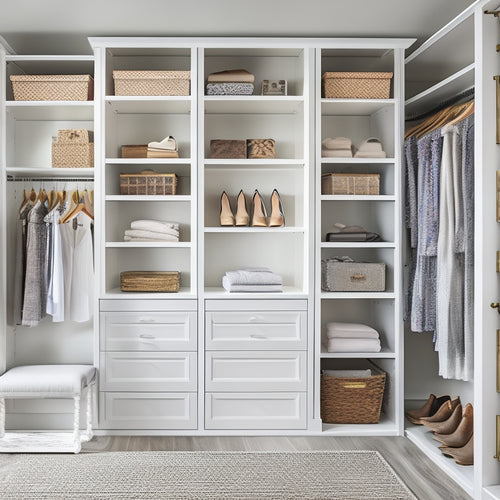
3 Best Decluttering Strategies for ADHD Minds
Share
You know your ADHD brain is capable of amazing things, but clutter and disorganization can hold you back. To tame the chaos, start by addressing your internal disorganization and recognizing how it reflects in your surroundings. Then, harness your unique strengths to break down decluttering into manageable chunks, preventing sensory overload. Finally, create a customized organizational system tailored to your strengths and weaknesses, and track your progress to stay motivated. By implementing these strategies, you'll be well on your way to corralling clutter and unleashing your full potential - and there's even more to discover.
Key Takeaways
• Break down decluttering into manageable chunks to prevent sensory overload and maintain focus.
• Create a sense of control and direction by dividing tasks into smaller, visually organized steps.
• Use novelty and excitement to stay engaged, such as turning decluttering into a game or challenge.
• Focus on creating mental clarity, not just removing items, to address internal disorganization.
• Recognize and manage sources of internal chaos, as it reflects in surroundings, to maintain a clutter-free environment.
Taming the Chaos Within
As you stand amidst the clutter, acknowledge that the chaos you see is often a reflection of the chaos within, and addressing the internal disorganization is vital before tackling the external mess. It's imperative to recognize that your surroundings are a manifestation of your mental state. Before you begin decluttering, take a step back and focus on 'taming the chaos within.' This means cultivating mental clarity and inner peace.
Start by identifying the sources of your internal chaos. Are you overwhelmed by thoughts, emotions, or responsibilities? Once you've pinpointed the culprits, develop strategies to manage them. This might involve mindfulness practices, journaling, or delegating tasks.
Decluttering With ADHD Brain
Now that you've tamed the internal chaos, it's time to harness your ADHD brain's unique strengths to tackle the physical clutter, and the first step is to break down the overwhelming task of decluttering into smaller, manageable chunks. This will prevent feelings of sensory overload, which can be debilitating for individuals with ADHD. By dividing the task into smaller tasks, you'll create a sense of control and direction, allowing you to focus on one area at a time.
As you begin to declutter, remember that your ADHD brain is wired to respond to novelty and excitement. Use this to your advantage by turning decluttering into a game or a challenge. Set a timer, put on some music, and see how much you can accomplish in a short amount of time. This will help you stay engaged and motivated.
Additionally, remember that decluttering isn't just about getting rid of physical items, but also about creating mental clarity. As you remove clutter, you'll feel a sense of clarity and calm, allowing you to focus on what's truly important.
Organizing for Focus and Flow
You'll turbocharge your productivity by creating a customized organizational system that caters to your ADHD mind's unique needs and preferences. By tailoring your system to your individual strengths and weaknesses, you'll be able to stay focused and maintain momentum.
To get started, identify your most Productive Habits and incorporate them into your daily routine. This could mean dedicating a specific time slot to a particular task or using a specific tool to stay organized.
| Task | Visual System | Benefits |
|---|---|---|
| Prioritize tasks | Color-coded sticky notes | Visualize tasks and prioritize easily |
| Break tasks into steps | Mind mapping | Clarify complex tasks and identify dependencies |
| Track progress | Habit tracker | Stay motivated and see progress |
Frequently Asked Questions
Can I Declutter if I'm Overwhelmed by Sentimental Item Decisions?
When faced with sentimental items, you're not alone in feeling overwhelmed. Recognize that emotional attachment is real, and decision fatigue is a common obstacle. Start by acknowledging these feelings, then break down the decision-making process into smaller, manageable tasks to regain control.
How Do I Maintain Organization Systems When I Get Bored Easily?
When you get bored easily, you'll maintain organization systems by setting up reward systems, like treating yourself after tasks, and habit stacking, where you link new habits to existing routines, making it harder to slack off.
Are There Any Decluttering Strategies Suitable for ADHD Children?
"When you're trying to corral a whirlwind, start with small steps. For ADHD kids, use visual timers to create a sense of control, and implement reward systems to make decluttering a fun, achievable challenge."
Can Professional Organizers Help Individuals With ADHD Declutter Effectively?
You can greatly benefit from working with a professional organizer who provides customized guidance and expert accountability, helping you stay focused and motivated to declutter effectively, even with ADHD.
Is It Possible to Declutter Without Wasting a Lot of Time and Energy?
You can declutter efficiently by prioritizing tasks, breaking them into manageable chunks, and allocating specific Time Blocks for each task. Additionally, incorporate Energy Hacks, like taking regular breaks, to conserve your mental and physical resources.
Related Posts
-

Maximizing Small Closets With Custom Shelving Solutions
You're tired of feeling like your small closet is cramped and cluttered, but with custom shelving solutions, you can ...
